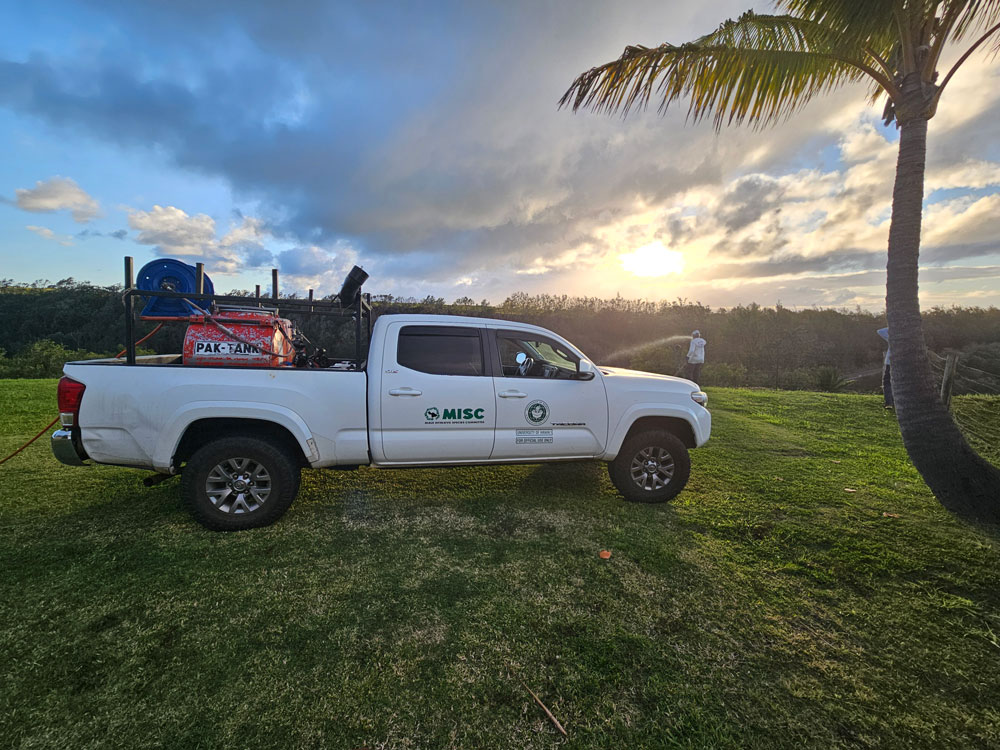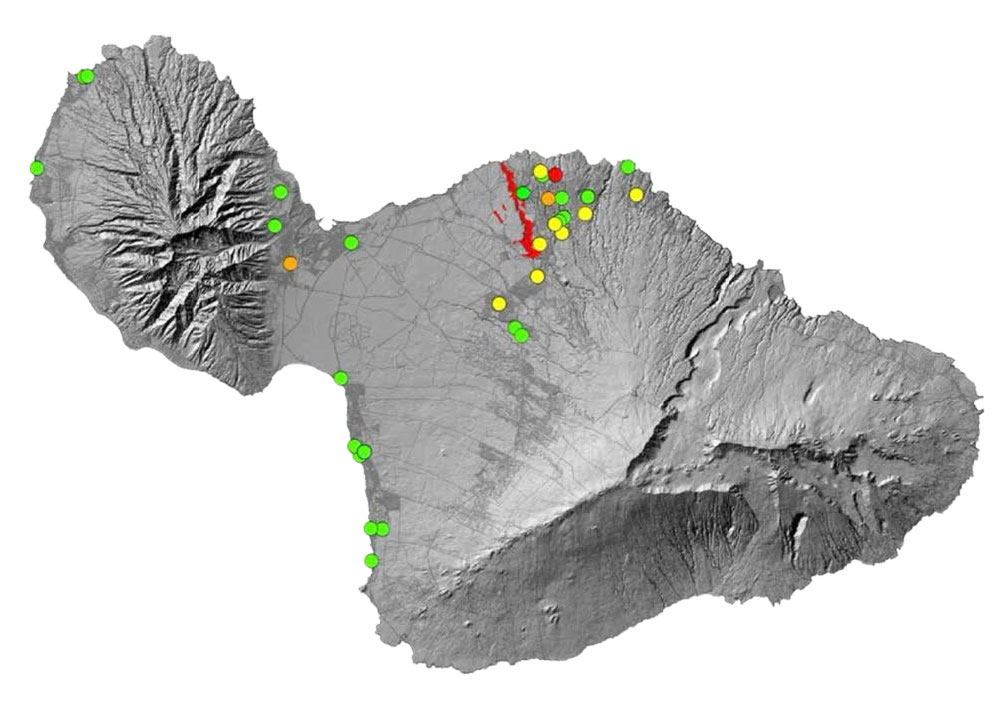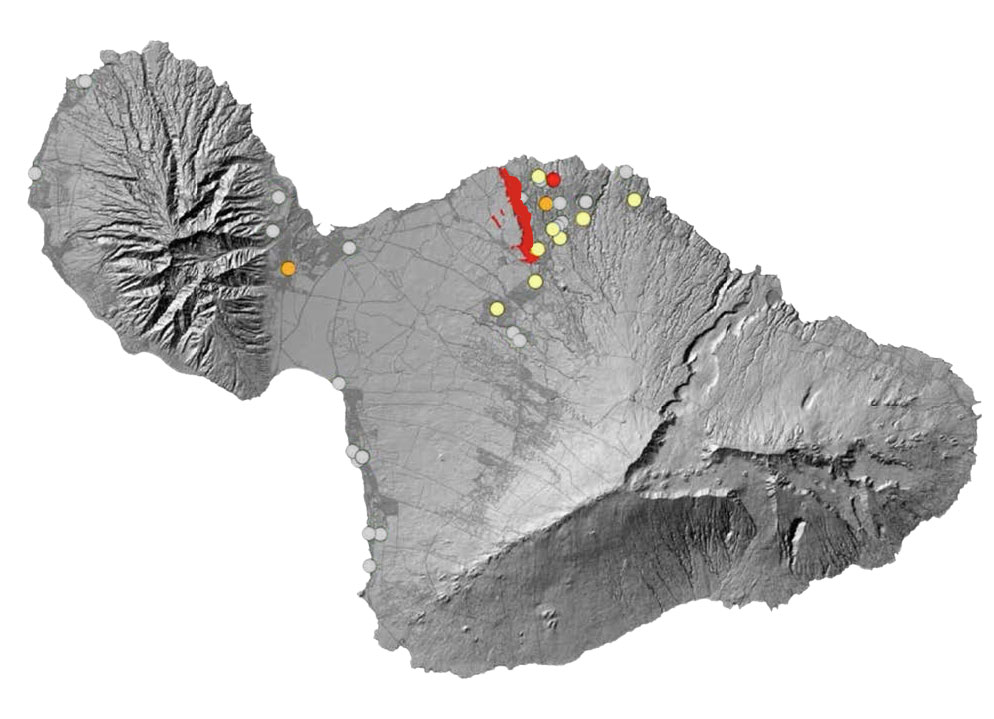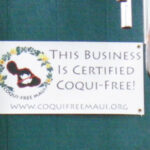
Coqui Frog Response on Maui County
Eleutherodactylus coqui
Program Goal: MISC’s response prioritizes preventing further spread while supporting impacted communities
Status: The core coqui population is limited to a six-square mile area in Haʻikū from Māliko Gulch at the western edge to Kuiaha Gulch on the east. It spans from roughly Kaluanui road at the uppermost mauka extent to the ocean at Māliko Bay.

Coqui Biology:
- Native to Puerto Rico, coqui are kept in check in their natural range by snakes, spiders, and other factors.
- On Maui, lacking these predators, they reach densities of 91,000 frogs per hectare, more than double their density in native habitat
- Males call at night to defend territory and attract mates
- Thrive in dense vegetation and damp environments, eating ants and other invertebrates. Coqui do not eat a significant number of mosquitos

Why Control Coqui?
- Cultural & Community Well-being – Coqui frogs disrupt Hawaiʻi’s unique natural soundscape. The male’s call, “Co-QUI,” can reach 90–95 decibels, comparable to a power tool. With thousands calling at night, coqui drown out the sounds of crickets, ocean waves, and wind. Prolonged exposure to this volume can even lead to hearing loss.
- Environmental Impact – Hawaiʻi has no native amphibians. Coqui eat a wide range of invertebrates, threatening native species and disrupting ecosystem balance. Their presence can fuel the dominance of other invasive species. Learn more about the coqui frog
Program History & Evolution
Timeline of Coqui on Maui
- Late 1980’s, coqui frogs were introduced to Hawaii
- 1998: Eight known populations on Hawaii Island
- 2001: Kraus et. al estimates 200 populations throughout the state including Maui, Oahu, and Kauai
- Early 2000s: Control techniques explored including solutions of caffeine, pyrethrins, baking soda, and citric acid. A 16% solution of citric acid
- 2004: Community “Frog Squad” begins control efforts
- 2005: MISC begins landscape level control of coqui populations across Maui County. Estimated 17 separate population centers with single frogs regularly showing up
- 2006: 11 of 17 populations eliminated; significant population in Maliko Gulch remains largest challenge
- 2006-2008: containment efforts within Maliko focused building a gravity – fed pipeline to treat frogs within gulch
- 2008: Launch of Coqui free nursery program
- 2013: Heavy rains cause flooding in Maliko, washing away much of the pipeline infrastructure
- 2014-2017:With given resources, MISC shifts response to areas outside of Maliko to lessen impact and spread throughout community. Elimination of outlier populations away from core becomes priority
- 2018: Launch of Community Coqui Control Program to empower homeowners to control coqui
- Today: ongoing containment efforts focused on limiting the spread of coqui to new areas. Our efforts and community participation have led to the eradication (complete elimination) of coqui from 26 sites across Maui.
How We Respond
MISC’s strategy relies on community action, smart prioritization, and strategic containment.
Strategic approach: Any successful response to coqui frogs relies on the collective kuleana of our community. From preventing new populations from arriving from off-island to stopping spread from existing populations to mitigating the impacts in affected neighborhoods, many agencies, organizations, and individuals are involved
- Border Prevention: Hawaii Department of Agriculture inspects material coming to Maui to prevent new introductions.
- Stopping Spread: Plant nurseries and retailers protect their customers from coqui through best management practices and MISC’s coqui free nursery program.
- Rapid Response: MISC focuses on two key strategies: eliminating small, outlier populations to prevent new establishment, and reducing established infestations by targeting coqui in steep gulches and unmanaged habitat.
- Coordinated Suppression: Neighbors collaborate on efforts to manage coqui frogs in their own yards. MISC provides training and tools in support of the effort.
MISC prioritizes our field efforts to ensure effective use of resources and support community engagement. Specifics vary by staffing and funding, but overall, the following reflects how MISC prioritizes our resources:
Detection methods: Nighttime surveys for calling frogs help the community and our crew identify where the frogs are. Males are territorial and tend to return to the same area to call at night.
Habitat management: If coqui are present in an area, reducing habitat reduces density AND increases efficacy of control. Remove dense overgrown vegetation, mow cane grass back, and remove green waste appropriately by taking it to the county green waste facility. Some plants—bromeliads, heliconias, gingers, and bananas—are favored by coqui, so consider that when planting and maintaining a landscape in the presence of coqui.
Treatment Techniques:
- Hand Capture: Effective against a single frog or small population, hand capturing guarantees removal of a single frog with patience. However, females or juveniles are less likely to be caught as they are not vocalizing.
- Nighttime application of a 16% citric acid solution effectively controls coqui populations when it comes in contact with adults and eggs. Effective control requires direct contact and there is no residual efficacy. Citric solution has proven to be effective with minimal non-target impacts. The solution breaks down quickly and only frogs and soft-bodied invertebrates are affected by the solution. Learn more about the use of citric acid in the environment
- Hot water: University of Hawaiʻi-CTAHR researcher, Dr. Arnold Hara, developed a hot water treatment method for killing coqui and eggs in shipping containers. While it works well in an enclosed space, MISC has tried using this in a landscape setting with unsatisfactory results.
Results & Progress:
MISC has successfully eradicated coqui populations at 26 sites across Maui between 2004-2024. Infested areas range from ⅓ of an acre to over 16 acres. Eradication requires repeated sustained efforts over time, and these examples show eradication is possible.
Eradication timelines vary by complexity, with factors including infestation size and density, accessibility and terrain, vegetation complexity, and operational obstacles such as property access permission.
Maui and Hawaiʻi Island both saw introductions of coqui frogs at about the same time. With funding, Maui Invasive Species Committee pursued control efforts, and while the infested area within the core infestation zone has grown, MISC’s early and sustained control efforts have contained the population to this single area rather than allowing spread across the entire island.
In 2018, recognizing that the coqui population had expanded beyond likely resource allocation for eradication, MISC launched a community engagement program to train and support neighborhood-wide efforts of homeowners and residents to take back their quiet nights.

FAQ:
Click on any question below to see the answer.
Has MISC successfully eliminated coqui populations?
Yes! MISC has successfully eradicated coqui populations at 26 sites across Maui between 2004-2024, with infested areas ranging from ⅓ of an acre to over 16 acres.
How long does eradication take?
Eradication timelines vary significantly—from 1-2 years for simple sites to 10+ years for complex infestations. Factors include infestation size, terrain difficulty, vegetation complexity, and operational challenges like property access.
What is MISC doing to prevent new infestations?
MISC prioritizes eliminating small, outlier populations before they can establish and expand. We also work with plant nurseries on prevention and treatment, and we’ve installed a 3-mile barrier along Māliko Gulch to reduce frog movement into adjacent neighborhoods.
Can coqui frogs be completely eradicated from Maui?
While MISC has successfully eradicated 26 populations, the core infestation in Haʻikū has grown beyond likely resource allocation for complete eradication. However, our efforts have successfully prevented island-wide establishment, and community engagement programs help residents manage local populations.





